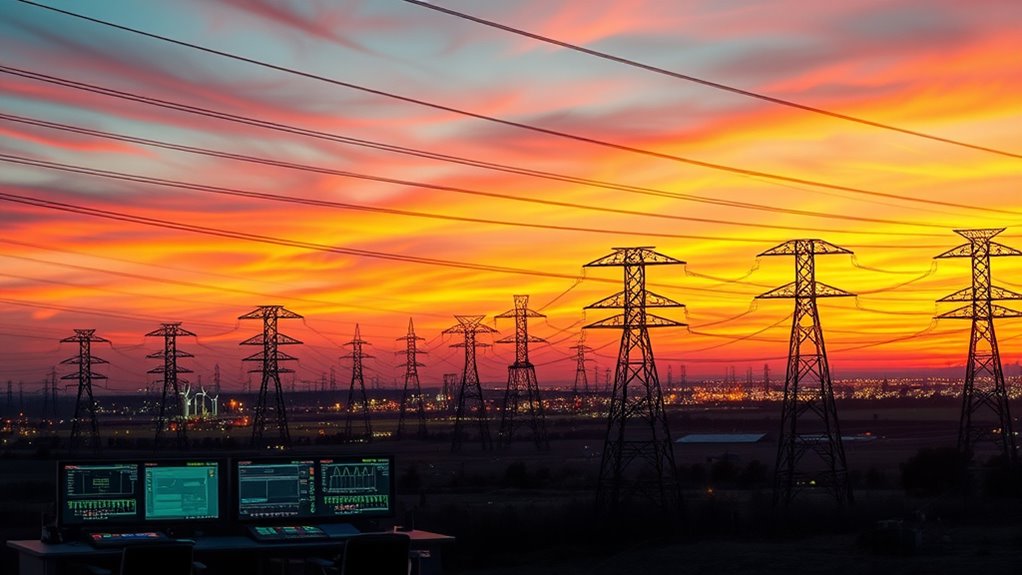By 2025, advanced grid modernization efforts will guarantee your regional power system remains stable and resilient, even with increased renewable energy sources like wind and solar. Upgrades include smart sensors, automation, and energy storage that help manage fluctuations and unpredictability. Better regional coordination and innovative control systems will boost reliability and prevent outages. If you want to discover how these improvements will shape the future of power stability, keep exploring the evolving energy landscape.
Key Takeaways
- Advanced grid automation and smart technologies will enhance real-time monitoring and rapid response capabilities.
- Increased energy storage deployment will better manage renewable intermittency and stabilize regional supply.
- Cross-regional energy transfer integration will improve balance and reduce blackout risks.
- Infrastructure upgrades will support higher renewable penetration, ensuring consistent grid stability.
- Enhanced resilience measures will mitigate extreme weather impacts and ensure reliable power delivery.

Have you ever wondered what keeps the lights on across a region? It’s a complex dance of infrastructure, technology, and policies working together to guarantee a steady flow of electricity. As the world shifts toward cleaner energy sources, your regional power grid faces new challenges and opportunities. One of the most critical aspects is renewable integration. Incorporating solar, wind, and other renewable sources into the grid isn’t as simple as flipping a switch. These sources are intermittent and unpredictable, which can threaten grid stability if not managed properly. That’s where grid modernization comes into play. Modernizing the grid involves upgrading infrastructure, deploying advanced control systems, and leveraging smart technologies that allow you to balance supply and demand more effectively.
By integrating renewables more seamlessly, your region can reduce reliance on fossil fuels, cut emissions, and promote sustainability. But it also requires a smarter, more flexible grid that can adapt to fluctuating energy inputs. Grid modernization involves installing advanced sensors, automation, and communication systems that give operators real-time data. With this, you can quickly respond to changes in renewable output or sudden demand spikes. This process also includes expanding energy storage options, like batteries, which help smooth out the variability of renewable sources. As a result, the grid becomes more resilient, capable of handling unexpected outages or extreme weather events without causing widespread blackouts. Additionally, ongoing innovations in battery storage technologies are vital for managing renewable variability and enhancing grid stability.
Furthermore, investments in grid modernization enable better coordination between different energy sources and regions. This interconnectedness ensures that excess renewable energy generated in one area can be transferred efficiently to where it’s needed most. You benefit from increased reliability and fewer interruptions because the system can reroute power dynamically. As you look toward 2025, expect these advancements to become more widespread, making your regional grid smarter and more adaptable. The integration of renewable energy and grid modernization efforts will not only stabilize your power supply but also support the transition to a cleaner, more sustainable energy future.
In essence, keeping the lights on in 2025 and beyond hinges on your region’s ability to modernize its power grid and effectively integrate renewable sources. These innovations empower you to handle the complexities of a decarbonized energy landscape, ensuring reliable electricity for homes, businesses, and critical services. It’s a future where technology and sustainability go hand in hand, securing a resilient and clean energy system for everyone.
Frequently Asked Questions
How Will Renewable Energy Integration Affect Grid Stability?
You’ll find that integrating renewable energy can challenge grid stability, but energy storage and grid modernization help manage these fluctuations. Energy storage systems store excess energy for later use, ensuring a steady supply. Grid modernization upgrades infrastructure, improves real-time monitoring, and enhances responsiveness. Together, these innovations allow you to harness renewable energy more effectively, maintaining a reliable, resilient power grid while reducing reliance on fossil fuels.
What Cybersecurity Measures Are Planned for the Power Grid?
You’ll see enhanced cybersecurity protocols implemented across the power grid to safeguard against cyber threats. These include robust threat detection systems that monitor for unusual activities and potential breaches in real-time. Regular updates and training ensure staff can respond quickly to any incidents. By prioritizing these measures, the grid’s resilience increases, keeping your energy supply secure and minimizing downtime caused by cyberattacks.
How Will Climate Change Impact Grid Infrastructure Resilience?
You’ll find that climate change is a double-edged sword, making your grid more vulnerable yet pushing you to adapt. As storms intensify and temperatures rise, climate adaptation strategies and infrastructure upgrades become essential. These efforts strengthen resilience, helping your power system withstand extreme weather. If you stay proactive, your grid can weather the storm and emerge stronger, ensuring reliable energy despite the changing climate.
What Role Will Artificial Intelligence Play in Grid Management?
AI will revolutionize grid management by enabling AI-driven forecasting, which predicts demand and supply fluctuations more accurately. You’ll see smarter demand response systems that adjust consumption in real-time, reducing strain on the grid. This proactive approach helps prevent outages and integrates renewable energy sources seamlessly. With AI, you’ll benefit from a more resilient, efficient, and adaptable power grid that responds swiftly to changing conditions, ensuring stability and sustainability.
How Will Cross-Border Energy Trade Influence Regional Stability?
Cross-border energy trade will markedly enhance regional stability by promoting energy market integration and fostering cooperation through clear cross-border policies. When you support these policies, you enable a more resilient grid, reduce supply disruptions, and balance supply and demand across borders. This interconnected approach allows you to optimize renewable resources, lower costs, and improve overall grid reliability, ensuring stable energy supply for everyone in the region.
Conclusion
As you look ahead to 2025, remember that a stable power grid isn’t just about technology—it’s the heartbeat of your community’s future. By staying vigilant and adaptive, you become the guardian of progress, ensuring energy flows smoothly like a steady drumbeat. Just as every drop sustains the ocean, your efforts sustain the grid’s resilience. Embrace your role, for in this dance of electrons, your actions light the path toward a brighter, more reliable tomorrow.









